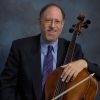
The Joy of Feuillard – A Sequential Approach to Teaching Bow Technique (Part 24 – Feuillard No. 35 – Theme and Variations #1-2)
Robert Jesselson
With today’s blog we will begin our look at the Feuillard Theme No. 35, and the variations on that page which deal with string crossings on three strings. The main issue will be trying to get smooth connections while crossing the strings. This is a lifetime occupation for cellists and other string players. It is relatively easy to play legato on one string, but to play legato while changing strings is truly difficult.
There are a number of things we can do to try and get smooth string crossings. One of the concepts, as mentioned before, is to overlap the notes slightly – just as pianists do when they play legato. Another thing we can do is to make sure that there is a nice “ring” to the sound, so that the resonance of one note connects with the resonance of the next note. Another thing is not to accent the beginning of notes as one changes strings.
Vibrato also helps with connecting the vibrations of the notes. In order to connect the vibrato of different fingers while changing strings one must release the fingers on notes that are not being played. In order to do this, it is helpful to use a large twisting motion in the upper torso. In doing so, we don’t have to lift the fingers that are not being played on the other strings – the arm motion takes care of that. I will go into more detail about this in the videos and in the upcoming variations.
The videos on this page will feature my high school student Zach. He has studied with me for two years, and has gone through all the previous pages of the Feuillard bowing exercises.
No. 35 Theme:

The theme should be played with the feeling of a downbeat pulse on the top double-stop. In other words, if a pianist were to play with us, the bottom double stop (G and D string notes) would be placed slightly before the downbeat. It is like playing the beginning of the Elgar concerto.
In playing the theme I ask the students to use left/right motion, and then I re-introduce the twist motion concept. The students will have dealt with this on earlier pages of the Feuillard, however with No. 35 it become essential to use the twist. Without this motion of the upper body they won’t be able to play with vibrato, and the left arm will become rigid. The upper torso makes a slight rotating movement to support the fine muscles of the wrist and fingers. It usually takes two lessons for students to internalize all these issues.
The little finger is the weakest finger for most people. We discussed doing isometrics to help strengthen the little finger in my “Warm-Up” blogs on CelloBello (go to Blog 14: https://www.cellobello.com/cello-blog/in-the-practice-room/100-cello-warm-ups-and-exercises-blog-14-isometrics-strength-and-articulation-exercises/ ). Another good way to strengthen the little finger – related to the work we are doing here in No. 35 – is to play fifths and fourths. This is also a good ear-training exercises, and we need the ability to play fourths and fifths in Bach.
With these videos and the small snippets from the lessons that are being presented, it may be difficult to recognize how hard the students have to work to achieve their results. We worked on the fourths and fifths in three lessons, and Zach had to be determined to be able to play them well, so I asked him to remember one of my favorite quotes from Albert Einstein:
Variation #1:

Variation #2:

Many of these variations will take at least two lessons for the students to absorb the information and play them well enough to “pass off”. Of course I always have to evaluate when it is more important for the students to stay on a variation to try and improve it, and when I need to “let go” of some aspect of the playing (eg a “blip” in the performance, or some intonation issue, etc) and pass them off.
So, even though it was not “perfect”, Zach is starting to get the main issue involving the twist motion. As he continues his work with these variations, I hope that it will become ingrained as a habit so we can work on other aspects of these string crossing exercises, such as vibrato and improving the sound and intonation.
Next week we will work with various combinations of legato and staccato strokes over three strings. We will also review the difference between up-bow staccato and flying spiccato, and address how these exercises are helping students improve the ability to concentrate that has implications on learning repertoire.
*If you have questions or comments about The Joy of Feuillard, Dr. Robert Jesselson can be reached directly at rjesselson@mozart.sc.edu.
Subjects: Repertoire, Technique
